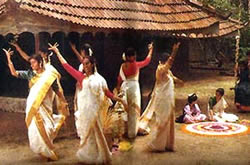|
|
The
most important festival of Kerala, is observed in August-September for
ten days. The festivals celebrated the symbolic return of the legendary
demon-king, Mahabali, who is said to have been very popular among his
subjects. Mahabali was a two-sided character: he brought tremendous prosperity
to his kingdom and was therefore loved and respected by his people. On
the other hand, the king had deprived the gods of all their possessions
and due to his egoistic attitude, had declared supremacy over the earth
and the heavens.
| In his
fifth incarnation, known as the Dwarf incarnation, Lord Vishnu assumed
the form of dwarf Brahmin boy in order to punish Mahabali for his
devilish deeds. One day Mahabali performed a horse sacrifice and
because of his generosity, declared that he would grant anything
that anyone asked for. The Dwarf approached the court of the king
and asked for |
 |
enough space in which the Dwarf could take three
steps. The king granted the request, and the Dwarf suddenly assumed a
gigantic form. His first step covered the earth, the second the heavens,
and the third step landed on the head of the king, sending him flying
to the underground. Thus the earth and the heavens, which had been claimed
by Mahabali were recovered by the gods, Lord Vishnu.
The above mythological story has deep philosophical significance. Mahabali,
the demon-king, symbolizes a human being who normally has both the bright
and the dark side to the character. The three steps of the Dwarf represent
the three states of human consciousness (awake, dream, and deep sleep).
When the ego is destroyed (symbolized by the Dwarf's third step which
landed on the head of Mahabali), an individual gains divine consciousness,
which leads to eternal joy.
Onam is celebrated in the spring season in Kerala, when the sky is blue,
the fields are green, the rivers are full with calm and clear water, and
the gardens are abundant with fruits and flowers. In this backdrop of
natural joy, young children gather flowers during each morning of the
festival and arrange them in circles. Also during each day of the festival,
a new, larger concentric circle is added. The flower decorations are eventually
replaced by a deity of clay or mud, known as the Lord of the Onam. The
deity has a square bottom, four faces, and a pointed top. The flower designs,
which are expanded each day of the festival, symbolize the slow and steady
blossoming of the flower of life in an individual. The square bottom of
the deity symbolizes an individual, the four stages of life, and the pointed
top indicates pure divinity (union with God). Thus the entire celebration
of onam symbolizes the slow ascent of an individual consciousness to the
divine consciousness, the storehouse of eternal joy.
On the social side, Onam provides an opportunity for family reunions,
exchanging presents with friends and relatives, filling one's wardrobes
with beautiful clothes, reviving social contacts through dinner parties
and gifts and eating delicacies prepared specially for the festival. Overall,
the festival inculcates a sense of oneness among people.
©
2001 vandemataram.com All rights reserved
|
 |